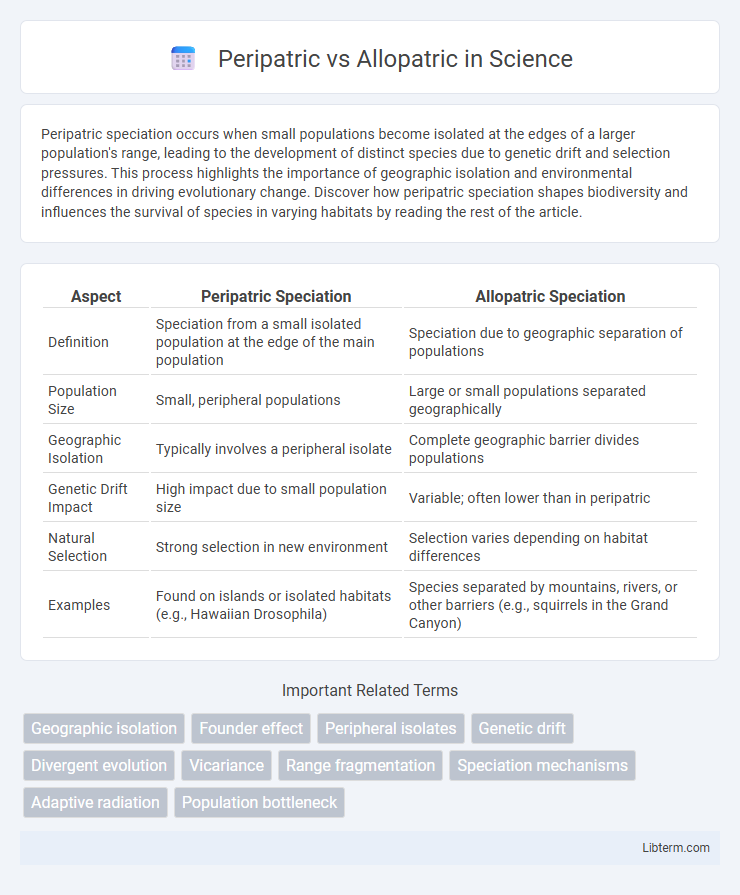Peripatric speciation occurs when small populations become isolated at the edges of a larger population's range, leading to the development of distinct species due to genetic drift and selection pressures. This process highlights the importance of geographic isolation and environmental differences in driving evolutionary change. Discover how peripatric speciation shapes biodiversity and influences the survival of species in varying habitats by reading the rest of the article.
Table of Comparison
| Aspect | Peripatric Speciation | Allopatric Speciation |
|---|---|---|
| Definition | Speciation from a small isolated population at the edge of the main population | Speciation due to geographic separation of populations |
| Population Size | Small, peripheral populations | Large or small populations separated geographically |
| Geographic Isolation | Typically involves a peripheral isolate | Complete geographic barrier divides populations |
| Genetic Drift Impact | High impact due to small population size | Variable; often lower than in peripatric |
| Natural Selection | Strong selection in new environment | Selection varies depending on habitat differences |
| Examples | Found on islands or isolated habitats (e.g., Hawaiian Drosophila) | Species separated by mountains, rivers, or other barriers (e.g., squirrels in the Grand Canyon) |
Introduction to Speciation: Peripatric vs Allopatric
Peripatric speciation occurs when a small population becomes isolated at the edge of a larger population, leading to rapid genetic divergence through founder effects and genetic drift. Allopatric speciation involves geographic separation of populations by physical barriers such as mountains or rivers, resulting in reproductive isolation and eventual species divergence. Both mechanisms contribute to biodiversity by driving the evolution of distinct species through spatial isolation and genetic differentiation.
Defining Peripatric Speciation
Peripatric speciation occurs when a small, isolated population at the edge of a larger population's range undergoes genetic divergence due to limited gene flow and distinct selective pressures. This form of speciation is characterized by the founding effect, where the peripatric population's genetic makeup differs drastically from the main group, leading to rapid evolutionary change. Unlike allopatric speciation, which involves geographic separation by large physical barriers, peripatric speciation emphasizes isolation in marginal habitats with small population sizes.
Defining Allopatric Speciation
Allopatric speciation occurs when a population is geographically divided, leading to reproductive isolation and evolutionary divergence into distinct species. Unlike peripatric speciation, which involves small peripheral populations, allopatric speciation typically affects larger populations separated by physical barriers like mountains, rivers, or oceans. Genetic drift, natural selection, and mutation drive divergence during this separation, ultimately resulting in speciation.
Key Differences Between Peripatric and Allopatric Speciation
Peripatric speciation occurs when a small population becomes isolated at the edge of a larger population, leading to rapid genetic divergence due to a strong founder effect and genetic drift, whereas allopatric speciation involves geographic separation of populations that are usually of similar size, resulting in gradual genetic divergence over time. Peripatric speciation often features a smaller gene pool and faster speciation rates due to bottlenecks, while allopatric speciation relies on physical barriers like mountains or rivers that prevent gene flow. The scale of isolation and population size fundamentally distinguishes peripatric from allopatric speciation, impacting evolutionary dynamics and patterns of biodiversity.
Geographic Isolation in Peripatric and Allopatric Speciation
Peripatric speciation occurs when a small population becomes geographically isolated at the edge of a larger population's range, often involving a founder effect and rapid genetic divergence. Allopatric speciation involves complete geographic isolation of populations by barriers such as mountains, rivers, or distances, preventing gene flow and promoting independent evolutionary paths. Geographic isolation in peripatric speciation typically affects smaller, peripheral populations, while in allopatric speciation, it separates larger populations across extensive physical barriers.
Genetic Drift and Founder Effect in Peripatric Speciation
Peripatric speciation involves a small population becoming isolated at the periphery of the main population, where genetic drift dramatically alters allele frequencies. The founder effect plays a crucial role as the isolated group's limited genetic diversity leads to rapid divergence from the ancestral population. In contrast to allopatric speciation, which typically involves larger populations separated by geographic barriers, peripatric speciation emphasizes the impact of stochastic processes like genetic drift in driving evolutionary change.
Role of Population Size in Speciation
Peripatric speciation occurs in small, isolated populations where genetic drift and founder effects have a significant impact, accelerating divergence due to reduced genetic variation. Allopatric speciation involves larger populations separated by geographic barriers, with speciation driven primarily by natural selection and reduced gene flow over time. The disparity in population size influences the speed and genetic mechanisms contributing to reproductive isolation and species formation.
Case Studies: Examples of Peripatric and Allopatric Speciation
Peripatric speciation is exemplified by the evolution of Darwin's finches on the Galapagos Islands, where small isolated populations diverged from a common ancestor due to genetic drift and selection pressures. Allopatric speciation is well illustrated by the formation of the Kaibab squirrel and Abert's squirrel populations on opposite rims of the Grand Canyon, geographically separated and evolving independently over time. These case studies highlight the roles of geographic isolation and population size in driving speciation processes.
Evolutionary Significance of Peripatric and Allopatric Processes
Peripatric speciation, involving small isolated populations at the edge of a larger range, drives rapid evolutionary changes through genetic drift and strong selection pressures, promoting biodiversity in localized habitats. Allopatric speciation occurs when geographic barriers lead to the divergence of large populations over extended periods, fostering gradual accumulation of genetic differences and reproductive isolation. Both processes are critical for adaptive radiation and the generation of new species, shaping global patterns of biodiversity and evolutionary trajectories.
Summary: Comparing Peripatric and Allopatric Speciation
Peripatric speciation involves a small population isolated at the edge of a larger one, leading to rapid genetic divergence due to founder effects and genetic drift. Allopatric speciation occurs when populations are geographically separated by physical barriers, resulting in gradual reproductive isolation over time. Both mechanisms promote biodiversity through geographic isolation but differ in population size and the scale of evolutionary change.
Peripatric Infographic

 libterm.com
libterm.com